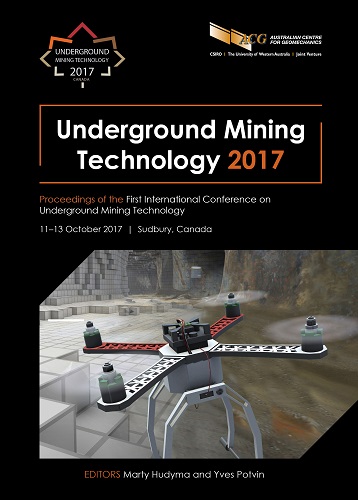Shotcrete: early strength and re-entry revisited – practices and technology

|
Authors: Rispin, M; Kleven, OB; Dimmock, R; Myrdal, R |
DOI https://doi.org/10.36487/ACG_rep/1710_03_Rispin
Cite As:
Rispin, M, Kleven, OB, Dimmock, R & Myrdal, R 2017, 'Shotcrete: early strength and re-entry revisited – practices and technology', in M Hudyma & Y Potvin (eds), UMT 2017: Proceedings of the First International Conference on Underground Mining Technology, Australian Centre for Geomechanics, Perth, pp. 55-70, https://doi.org/10.36487/ACG_rep/1710_03_Rispin
Abstract:
Shotcrete, a globally employed support system of choice in underground mining, is required to perform its support function not only over the expected life of underground openings, but also from a safety and productivity perspective, at a very early age. The balance between placement ability, early strength and longterm performance is a delicate one which has been repeatedly improved upon as shotcrete has proliferated in mining and tunnelling. Early strength is particularly important in safeguarding the integrity of underground openings and the people and machinery which need to return to them as quickly as safety doctrine allows. This paper covers the state-of-the-art with respect to practices and technology which forms the basis for the safest, earliest re-entry policies. Technologies discussed include the examination of strength development via thermal imagery, infrared analysis, fibre performance, admixture and accelerator formulation, and robotic placement. Practices discussed cover approaches in both mining and tunnelling, early re-entry times and policies, and lessons learned anecdotally from contemporary case studies. Preservation of people and assets, the environment and cost savings are co-drivers of industry advances.
Keywords: shotcrete, early strength, re-entry, set accelerator, infrared analysis, fibre, tunnelling
References:
Ahuja, V & Jones, B 2016, ‘Non-destructive approach for shotcrete lining strength monitoring’, Proceedings of the World Tunnel Congress, Society for Mining, Metallurgy, and Exploration, Englewood, pp. 1178–1187.
Bürge, TA, 2001, ‘Mode of action of alkali-free sprayed shotcrete accelerators’, in ES Bernard (ed.), Shotcrete: Engineering Developments, Proceedings of the International Conference on Engineering Developments in Shotcrete, A.A. Balkema, Rotterdam, pp. 79–85.
British Standards Institution 2006, BS EN 14488-2 Testing Sprayed Concrete – Part 2: Compressive strength of young sprayed concrete, British Standards Institution, London.
Crossrail Ltd 2014, Best Practice Guide - SCL Exclusion Zone Management, Document Ref: CRL1-XRL-C-GUI-CR001-50001, Crossrail Ltd, viewed 23 May 2017, www.britishtunnelling.org.uk
Dimmock, R, Rispin, M & Knight, B 2003, ‘Early re-entry into working faces in mines through modern shotcrete technology’, Canadian Institute of Mining, Metallurgy and Petroleum Annual General Meeting 2003, Canadian Institute of Mining, Metallurgy and Petroleum, Westmount.
Lee, ST, Kim, DG & Jung, HS 2009, ‘Sulfate attack of cement matrix containing inorganic alkali-free accelerator’, KSCE Journal of Civil Engineering, vol. 13, no. 1, pp. 49–55.
Myrdal, R 1999, ‘Modern chemical admixtures for shotcrete’, Proceedings of the Third International Symposium on Sprayed Concrete, pp. 373–382.
Myrdal, R 2011, ‘Chemical reflections on accelerators for sprayed concrete: past, present and future challenges’, Proceedings of the Sixth International Symposium on Sprayed Concrete – Modern Use of Wet Mix Sprayed Concrete for Underground Support, pp. 304–316.
Myrdal, R 2012, ‘From alkali-free to sulphate-free: current research on shotcrete accelerators’, hand-out document of presentation held at Shotcrete Seminar, Brisbane, 19 June 2012, Concrete Institute of Australia, Perth, 26 p.
Myrdal, R & Griffith, R 2014a, ‘The characteristics and performance of consistence control admixtures for sprayed concrete’, Proceedings of the Seventh International Symposium on Sprayed Concrete – Modern Use of Wet Mix Sprayed Concrete for Underground Support, pp. 294–304.
Myrdal, R & Griffith, R 2014b, ‘Admixtures for geopolymer concrete: the performance of accelerating admixtures’, Proceedings of the 2nd International Congress on Durability of Concrete, paper no. 24, 11 p.
Myrdal, R, Hansen, R & Tjugum, G 2001, ‘A new chemical approach to obtain high early strength in shotcrete’, in ES Bernard (ed.), Shotcrete: Engineering Developments, Proceedings of the International Conference on Engineering Developments in Shotcrete, A.A. Balkema, Rotterdam, pp. 193–196.
Ohta, A, Sugiyama, T & Tanaka, Y 1997, ‘Fluidizing mechanism and application of polycarboxylate-based superplasticisers’, in VM Malhotra (ed.), Proceedings of the Fifth CANMET/ACI International Conference on Superplasticisers and Other Chemical Admixtures in Concrete, paper no. SP 173–19, pp. 359–378.
Paglia, C, Wombacher, F & Böhni, H 2003, ‘The influence of alkali-free and alkaline shotcrete accelerators within cement systems. Influence of the temperature on the sulphate attack mechanisms and damage’, Cement and Concrete Research, vol. 33, pp. 387–395.
Prudêncio Jr, LR 1998, ‘Accelerating admixtures for shotcrete’, Cement and Concrete Composites, vol. 20, pp. 213–219.
Rispin, M, Knight, B & Dimmock, R 2003 ‘Early re-entry into working faces in mines through modern shotcrete technology – part II’; Proceedings of the Canadian Institute of Mining, Mine Operators Conference 2003, Canadian Institute of Mining, Metallurgy and Petroleum, Westmount.
Rispin, M, Kleven, OB, Robbins, M, Dimmock, R & Skogseth, T 2013, ‘Development in block cave mines’, Proceedings of the Safe, Rapid Development Conference 2013, International Mining, London.
Rispin, M, Melbye, T & Kraft, R 2009, ‘Sprayed concrete systems for present and future: logistics and application’, Mining Magazine Technology Conference 2009, Mining Magazine, London.
Rixom, R & Mailvaganam, N 1999, ‘Chapter 5’, Chemical Admixtures for Concrete, E&FN Spon, London, pp. 252–265.
© Copyright 2025, Australian Centre for Geomechanics (ACG), The University of Western Australia. All rights reserved.
View copyright/legal information
Please direct any queries or error reports to repository-acg@uwa.edu.au
View copyright/legal information
Please direct any queries or error reports to repository-acg@uwa.edu.au